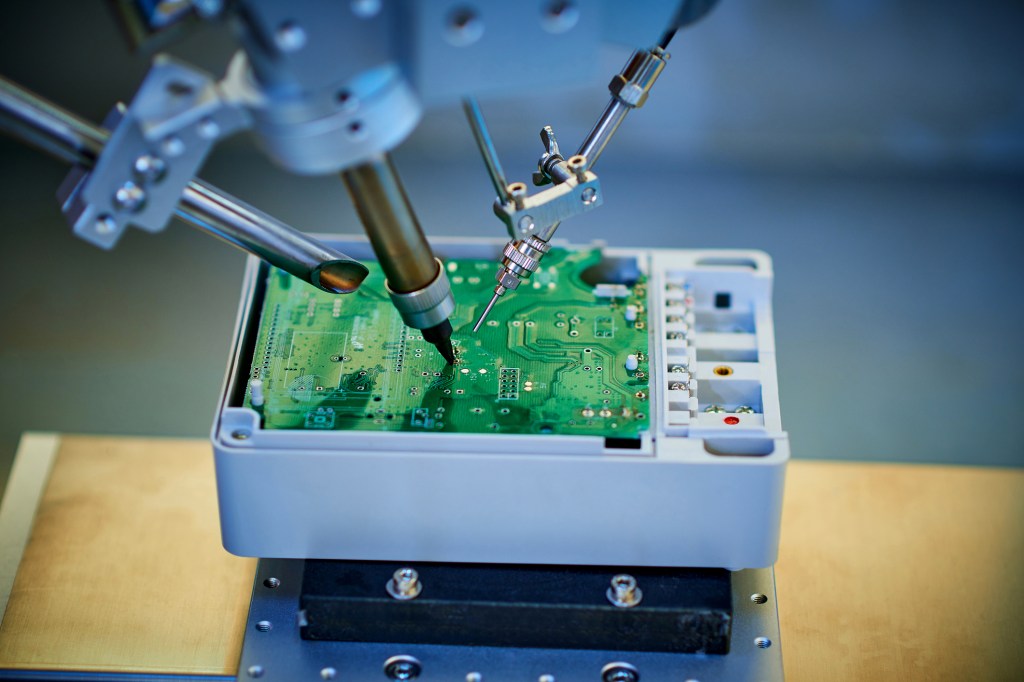The Biden administration is aggressively limiting China’s access to American technologies that are critical for semiconductor development, artificial intelligence (AI), and advanced computing. These new actions show the United States is not simply trying to slow China’s technological advancement, but to arrest and to contain it. But if this strategy is to succeed, policymakers will need to enforce these provisions consistently while also getting foreign allies to adopt similar measures. Industry leaders, likewise, need to understand and adapt to these changes, which are likely harbingers of even more disruption in the near- to mid-term.
What did Biden do?
On Friday, the White House published a series of new export controls that, when taken together, constitute a significant escalation in the economic and technological tensions between Washington and Beijing. In fact, one group of analysts published a detailed explanation of the rules under the title, “China and USA Are Officially At Economic War.” While I wouldn’t go quite that far, I understand their point. Here are the main muscle movements and what they mean.
First, 31 new Chinese entities are now on the Unverified List (UVL), which is managed by the Bureau of Industry and Security at the U.S. Department of Commerce. These companies were added to the UVL because the Chinese government will not allow the United States to verify that these entities are not illegally aiding prohibited groups, like the Chinese military or intelligence services. The listees are essentially presumed to be compromised and American exporters must meet more rigid standards before they can do business with them. But that’s only the beginning.
The UVL can also be a precursor to a company landing on the U.S. Entities List. When a foreign company is added to this list, U.S. companies are banned from exporting, reexporting, or transferring items to that foreign company without a government exemption. While the listed company can still sell its products to U.S. companies or individuals, it was precisely this action that dealt a massive blow to Huawei’s efforts in the United States, costing the company billions and limiting its access to, among other things, cutting-edge semiconductors.
Speaking of semiconductors, among the new members of the UVL is China’s Yangtze Memory Technologies (YMTC). I wrote recently about Apple’s selection of this company to provide NAND flash memory chips for its iPhones and I was, to put it politely, not supportive of this choice. Well, Tim Cook’s decision may be reversed for him if the American government continues to be stonewalled by YMTC and the other 30 companies added to the UVL—and I’m good with that.
The second major muscle movement is a series of complementary actions that tighten controls on key technologies by restricting the export of advanced tooling equipment, broadening foreign direct product rules, and constraining Americans from helping in the development, production, or use of semiconductors at specific Chinese foundries. Let me break it down into bite-size pieces.
- Advanced tooling equipment: It will now be harder for China to get U.S. equipment, or equipment made with, or dependent on, U.S. technologies or components that could be used to build out China’s semiconductor industry. Put simply: We’re not just preventing the sale of certain semiconductors, but also the sale of the tools and technologies necessary to design and build those semiconductors.
- Expanded foreign direct product rules: The U.S. is adding more semiconductors to the list of prohibited exports to China, particularly those essential for AI and supercomputers, and is also telling other countries that they cannot provide these chips to China if U.S. technology was used in any way for their design, development, fabrication, testing, or in any other manner. Bottom line: We’re telling countries like South Korea, Japan, and Taiwan to get on board with American efforts to cut off major chips supplies to the Chinese Communist Party (CCP).
- U.S. persons restrictions: This rule says U.S. persons cannot aid China on advanced chips without a license and is specifically aimed at preventing the transfer of valuable expertise—and it’s already working. At least three of the world’s leading tool makers for chip manufacturing have “suspended sales and services to semiconductors in China,” according to the Financial Times, and China’s chip manufacturing champion, Naura Technology Group, has removed all American employees from component and machinery development, according to the South China Morning Post.
Importantly, while most of these actions have exemptions the presumption on all of them is that no license will be granted. Which brings us to the subtext of all of this.
What do these new rules tell us about the broader strategy?
Last month, National Security Adviser Jake Sullivan foreshadowed these changes, saying, “We have to revisit the longstanding premise of maintaining ‘relative’ advantages over competitors in certain key technologies. We previously maintained a ‘sliding scale’ approach that said we need to stay only a couple of generations ahead. That is not the strategic environment we are in today. Given the foundational nature of certain technologies, such as advanced logic and memory chips, we must maintain as large of a lead as possible.”
Let me translate: The U.S. is no longer confident that it can simply outpace Chinese innovation in key technologies. It’s not enough to run faster, we also have to slow them down.
Sulivan’s point about the “foundational nature of certain technologies” is important. You see, semiconductors, AI, and supercomputers more broadly are increasingly becoming general purpose technologies (GPTs). These GPTs are more than just innovations. They will form the basis of entire industries, from banking to medicine and everything in between, with applications spanning virtually every sector of society. Rivalries between the United States and China over AI or microchips aren’t discrete areas of competition, they’re the whole game. And these new actions show that the Biden administration is finally starting to act like it.
What happens now?
Beijing will throw a tantrum. Next week, the CCP will convene its 20th Party Congress and is almost certain to select Xi Jinping to an unprecedented third term as the party chair. I expect Xi to point to these and other U.S. actions as provocations and as justifications for his country’s growing nationalism and belligerence. He will decry Western decadence and sing the praises of China’s totalitarian system. And then he’ll largely just have to deal with it because there’s not much he can do.
The reality that Xi faces, and that the United States is trying to use to its advantage, is that China is still dependent on U.S. technology, components, and expertise for its technological industries. Yes, Bytedance can train an amazing AI algorithm, but it won’t be worth very much if the company can’t get access to the necessary chips and computational power needed to use that algorithm. The same goes for cloud service providers like Alibaba: Those services don’t exist apart from American parts, technologies, and expertise. Even more, as this lack of access goes on, China’s ability to build new cutting-edge technologies will erode and they’ll be stuck right where they are now, with even these innovations slowly fading into irrelevance. Sure, some U.S. companies may experience some operational challenges in China as a form of reprisal, but none of this will be decisive and—I have to say—many of us have warned about such disruptions for quite some time.
So then, how should industry respond to all of this?
Well, if a company can pivot away from China, it should.These new rules from the Biden signal that we’re not going back to the “before times” anytime soon. The United States and China are decoupling. Our integrated markets, supply chains, and even the internet itself are all developing fissures along diverging national interests and no amount of happy talk or wishful thinking is going to paper over these divides. In fact, there’s growing consensus that a cataclysmic earthquake over Taiwan is just around the corner and that we’re only experiencing the first tremors of a far more disruptive future. Any company that wants to thrive in this emerging environment needs to start taking these challenges seriously and planning accordingly. This pivot doesn’t have to happen overnight, but time is certainly running out.
If a company cannot or will not pivot away from China, they should improve their position as best as they can and plan for significant disruption. No one should waste their time lobbying Congress or the White House about “mutually beneficial outcomes” or with warnings about how we’re at risk of “cutting our own throats.” The United States has tried for more than 40 years to work with China on outcomes where both nations responsibly thrive. These efforts have been rejected by the CCP, and now we have been forced into a new line of engagement based on resistance and confrontation. It’s sad, but true.
Even if they cannot completely move out of China, companies should move as much of their critical operations as possible into more stable alternatives, paying special attention to opportunities in the West. Democratic nations in Asia who hold special influence in technology—like South Korea, Taiwan, and Japan—are going to be under immense pressure to work with China and are at significant risk no matter what they do. If they help China, they risk crippling sanctions and other actions by the United States. If they don’t help China, they risk the wrath of their top trading partner. These risks are compounded if war breaks out over Taiwan, if for no other reason than the geographic proximity of these nations to where the fight will begin.
Western nations, however, will be forming technological alliances in the coming decade aimed at building trusted and resilient innovation ecosystems that can withstand Chinese influence and even military conflict. Companies that can help these alliances form and mature may find safe harbor from the coming storm. Those who tie themselves to the mast of the Chinese market and simply pray the storm passes them by could survive, but are more likely to be dashed on the rocks of Xi’s mercantilist policies.
But the U.S. government also faces some important choices.
All these new rules will be for naught if they are not enforced consistently and aggressively. In fact, poor enforcement will be worse than not having the rules at all, because it will signal that Washington isn’t serious, that it doesn’t have the stomach for the challenge before us, and that U.S. policymakers do not have the sense of urgency that is demanded by the moment. Better to be thought weak, then to fail to act and remove all doubt.
Instead, the United States should enforce these rules with rigor. And we should put on a full-court press with our partners and allies to see them enact and enforce similar rules. We must help our friends understand that the best way to avoid the costliest scenarios, is to act together now.
Both carrots and sticks will be essential. Positive inducements should include special privileges and protections for any member of our trusted technological alliances. These countries should enjoy “fast track access” to foreign direct investment in the United States as well as to American outbound investment and technology sharing. They should be beneficiaries of the prosperity and security that comes with an alliance with the United States, including burgeoning industrial bases and formidable militaries. This is the promise that should be held out to all nations who are willing to break from China, to adopt policies that are obviously good for their own interests, and to do their part in ensuring a geopolitical order based on human dignity and liberty.
For those friends who are not sufficiently motivated by these promises—and I say this out of love—we should put the screws to them. Nations who insist on keeping close ties to China and other authoritarian regimes should be pushed to the periphery and excluded from the benefits outlined above. It will be critical for the United States to find ways of easing the burdens of our friends in Asia who will face acute pressure. But they will all be forced eventually to choose a side, and we should do all that we can to make siding with China as unpalatable as possible. It’s called “tough love,” and governments need it too.
The Biden administration deserves real credit for its new export rules and for the broader approach these new measures suggest. Now Washington, Beijing, other nations, and the private sector are faced with a choice about what to do next. There is a path forward where responsible actors thrive. But there is no way without sacrifice. The sooner everyone accepts this and plans accordingly, the sooner we can begin building something even better than what we’ve known before. Let’s get to it.
That’s it for this edition of The Current. Be sure to comment on this post and to share this newsletter with your family, friends, and followers. You can also follow me on Twitter (@KlonKitchen). Thanks for taking the time and I’ll see you next week!





Please note that we at The Dispatch hold ourselves, our work, and our commenters to a higher standard than other places on the internet. We welcome comments that foster genuine debate or discussion—including comments critical of us or our work—but responses that include ad hominem attacks on fellow Dispatch members or are intended to stoke fear and anger may be moderated.
With your membership, you only have the ability to comment on The Morning Dispatch articles. Consider upgrading to join the conversation everywhere.